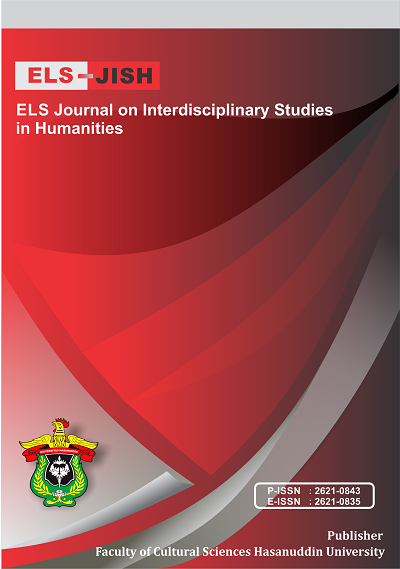English Fricatives Sound Pronounced by The Students’
DOI:
https://doi.org/10.34050/elsjish.v6i1.25688Keywords:
Fricative sound, Speaking, StudentsAbstract
In speaking, a good pronunciation is needed in order the communication will be run well. The purpose of this study was to know the sounds produced by fricatives in English and the factors that cause students to mispronounce them. The writers hope that students will understand more about the use of fricative pronunciation and that the results of this study can be used as a reference in teaching English, especially when pronouncing fricatives. This study focused on the description of fricatives. They were obtained from the eighth semester undergraduate students of the English Education department, University of Muhammadiyah Bone. The method of this study was a descriptive qualitative method. This data was obtained through interviews with students in the Department of English Education and analyzed the mispronunciation of English fricatives. As a result, Kenworthy identified factors that influence students' pronunciation: (1) native language, (2) age factor, (3) number of contacts, (4) vocal ability, (5) motivation and good pronunciation. As a result, the [v] sound is replaced with [f], the [ð] sound is replaced with the [d] and [t] sounds, and the [θ] sound is replaced with [ t ] and the replacement of the sounds [ z ] with [ s ]. Consistent with phonetic deletion of fricatives, they eliminated fricatives and eliminated word-ending sounds [θ].
References
Antaris, I., & Omolu, F. A. (2019). Factors affecting pronunciation difficulties of 8th grade students of MTSN Palu Barat. Journal of Foreign Language and Educational Research, 2(2), 10-19.
Çiftci, H., & Özcan, M. (2021). A Contrastive Analysis of Traditional Grammar Teaching and Communicative Language Teaching in Teaching English Grammar and Vocabulary. International Online Journal of Education and Teaching, 8(2), 709-729.
Fadhillah, N., Yassi, A. H., & Sahib, H. (2021). The Break Subtype of Affect-H in English And Buginese: Revisiting Dixon’s Theoretical Framework. ELS Journal on Interdisciplinary Studies in Humanities, 4(4), 510-514.
Gilakjani, A. P. (2016). English pronunciation instruction: A literature review. International Journal of Research in English Education, 1(1), 1-6.
Handayani, D. I. F. (2017). Teaching English pronunciation using film. Journal of English and Education, 5(2), 194-201.
Hasnia, H., Andini, C., Tahir, M. D., Hunaeni, H., Zulfikariandi, Z., & Muslimin, M. T. (2022). The Ability of 1st Class Students of SMAN 11 Enrekang to Arrange Verbal and Nominal Sentences. ELS Journal on Interdisciplinary Studies in Humanities, 5(3), 539-550.
Kenworthy, J. (1987). Teaching English Pronunciation. New York: Longman Group.
Kristina, D., & Rarasteja, Z. (2006). Pronunciation 1. Surakarta, Indonesia: Sebelas Maret University Press.
Marpaung, T. A., Sabarudin, S., & Mulyadi, M. (2021). Pronunciation Errors of Fricative Sounds Made by English Students. Journal of English Education and Teaching, 5(3), 368-380.
Miles, M. B., & Huberman, A. M. (1994). Qualitative data analysis: An expanded sourcebook. sage.
Mason, J. (2002). Qualitative Researching (2nd ed.). London: Sage Publicatons.
Nurhayati, D. A. W. (2020). Plosive and Fricative Sounds Produced by EFL Students Using Online Media: A Perspective on Learning English Phonology. In 1st International Conference on Folklore, Language, Education and Exhibition (ICOFLEX 2019) (pp. 221-227). Atlantis Press.
Rahman, F., Abbas, A., Hasyim, M., Rahman, F., Abbas, A., & Hasyim, M. (2019). Facebook Group as Media of Learning Writing in ESP Context: A Case Study at Hasanuddin University. Asian EFL Journal Research Articles, 26(6.1), 153-167.
Rahman, F. (2019). Some difficulties in verbalizing English words and phrases: A case study of suspected dyslexic children. Asian EFL Journal Research Articles, 6(26), 73-85.
Reed, M., & Levis, J. M. (2019). The handbook of English pronunciation. John Wiley & Sons.
Roach, P. (2009). English Phonetics and Phonology (4th ed.). Cambridge: Cambridge University Press
Roach, P. (2010). English Phonetics and Phonology. Cambridge: Cambridge University Press.
Rohmah, A. (2019). The Correlation Between Student’S Ability On Arabic Nathqul Lafdzi And English Pronunciation At Foreign Language Development Institute Of Nurul Jadid. (Doctoral dissertation, Universitas Islam Negeri Kiai Haji Achmad Siddiq Jember).
Said, M. M., Rita, F., Weda, S., & Rahman, F. (2021). English Language Performance Development Through Extracurricular Activities At Faculty Of Teacher Training And Education Tadulako University Palu. PalArch's Journal of Archaeology of Egypt/Egyptology, 18(08), 388-403.
Steinberg, D., Nagata, H., & Aline, D. (2013). Psycholinguistics: Language, mind and world. Routledge.
Sugiyono, S. (2010). Educational Research Methods: Quantitative, Qualitative, and R & D Approaches. Bandung: CV. Alfabeta.
Weda, S., Rahman, F., Atmowardoyo, H., Samad, I. A., Fitriani, S. S., Said, M. M., & Sakti, A. E. F. (2022). Intercultural Communicative Competence of Students from Different Cultures in EFL Classroom Interaction in Higher Institution. International Journal of Research on English Teaching and Applied Linguistics, 3(1), 1-23.
Downloads
Published
Issue
Section
License
Copyright (c) 2023 Ika Agustina, Andi Suwarni, Dewi Sartika, Rahmiati

This work is licensed under a Creative Commons Attribution-ShareAlike 4.0 International License.






